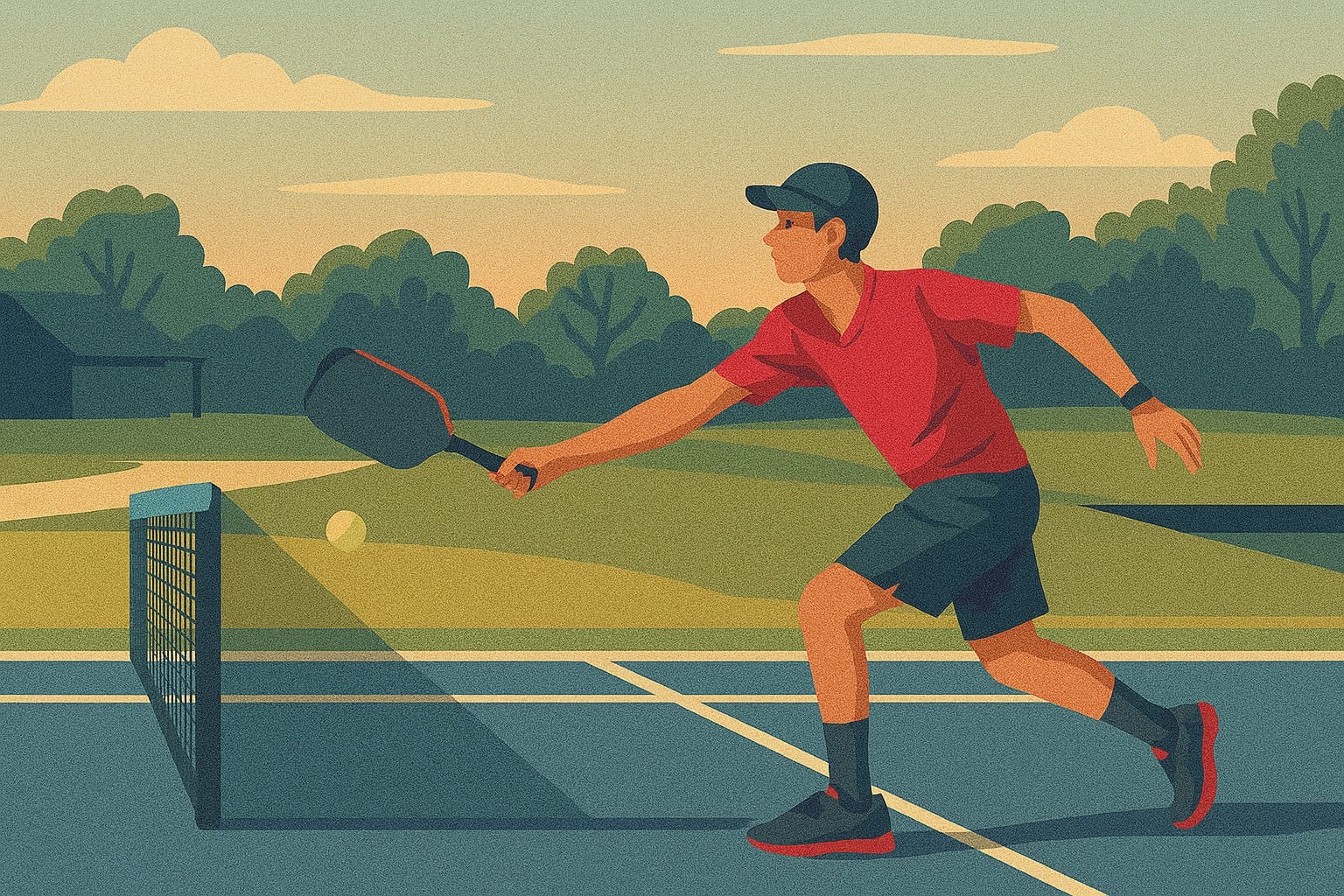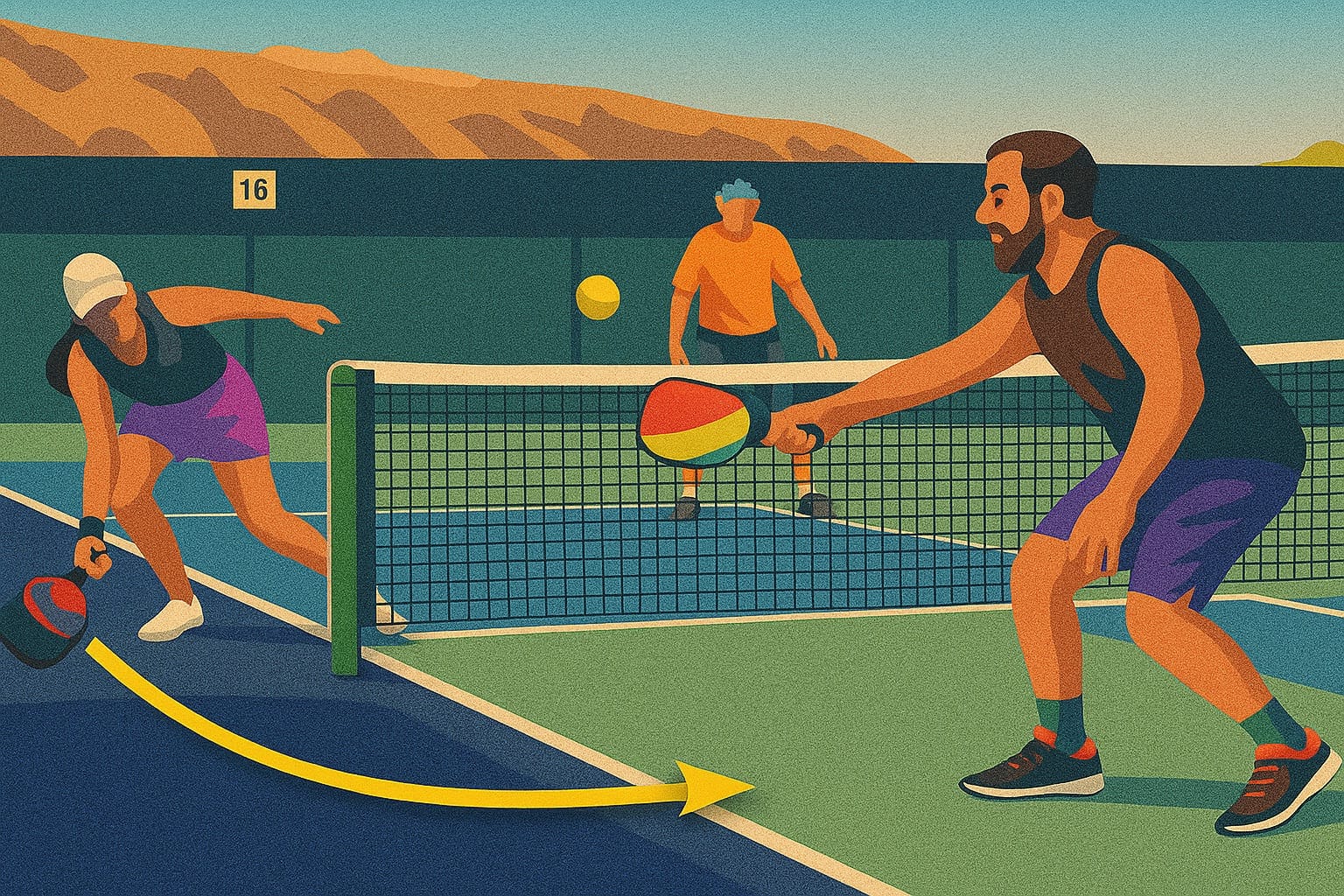Kitchen & Dinks: A Beginner’s Guide to Pickleball Lingo

Pickleball isn’t just one of the fastest-growing sports in America, it also comes with its own quirky language. If you’re new to the game, you might be scratching your head at terms like “kitchen” or “dink.” Don’t worry, you’re not accidentally in a cooking class. This conversational guide will walk you through 10 key pickleball terms, what they mean, when to use them, and why they’re important.
Kitchen (Non-Volley Zone)
In pickleball lingo, the “kitchen” is the Non-Volley Zone (NVZ), a 7-foot by 20-foot rectangle on each side of the net. This zone extends from the net toward the service line, marked by the kitchen line at its boundary. What’s the big deal? You can’t hit volleys while standing in the kitchen or touching the kitchen line, meaning you must let the ball bounce first if you’re in there.
Why such a rule? The kitchen exists to prevent giants at the net from dominating every point with quick volleys. It forces everyone to back up a bit and use skill instead of sheer height or reach. You can step into the kitchen any time as long as you’re not volleying. In fact, good players often step in to scoop up short balls (dinks) after they bounce, then quickly hop back out.
And why call it a kitchen anyway?
Honestly, nobody knows for sure. One popular story is that pickleball borrowed the term from shuffleboard (which has a scoring area nicknamed “the kitchen”), but it might just be a playful way to say “if you can’t stand the heat, stay out of the kitchen!” Either way, knowing what the kitchen is will keep you from getting burned by easy faults.
Dink Shot
A dink shot is a gentle, arching shot that you hit after the ball bounces, intended to land just over the net in your opponent’s kitchen. In plain terms: you’re basically tapping the ball lightly so it drops into the non-volley zone on the other side. This might sound like a simple mini drop shot, but in pickleball it’s essential.
When do you use a dink? All the time, especially in the classic soft game when both teams are at the net. Imagine you and your opponents are dueling at the kitchen line – nobody wants to pop the ball up high (or they’ll eat a smash). So, players exchange dinks: gentle, precise hits that barely clear the net and bounce in the kitchen. Why is dinking so important? Because it’s the great equalizer. A good dink can take the wind out of an aggressive opponent’s sails, they’ll be forced to hit upward on the ball, since it’s so low, making it hard to smash. And if they get impatient and try to crush a dink that wasn’t high enough? Hello, net, or an easy counterattack for your team.
Double Bounce Rule
If you’re a total newbie, the Double Bounce Rule might sound like something out of a trampoline park. But on the pickleball court, it’s a fundamental rule designed to keep things fair and fun. Here’s the deal: after the serve, each side must let the ball bounce once before volleys are allowed. Both teams have a chance to hit a groundstroke before the net frenzy begins.
Erne
No, not Ernie like Bert’s buddy on Sesame Street, Erne (pronounced “urn”) is one of the flashiest, most impressive shots in pickleball. It even has a cool backstory: the shot is named after a player, Erne Perry, who popularized it in high-level play around 2010. An Erne is essentially a legal way to cheat the kitchen and leap right next to the net for a slam. How do you do that without breaking kitchen rules? By going around it. In an Erne, a player positions themselves at the side of the kitchen, often even stepping just outside the court sidelines, then jumps or runs past the NVZ to volley the ball in mid-air near the net.
Around the Post (ATP)

The Around The Post shot is a crowd-pleaser that looks almost impossible until you’ve seen it happen. Most of the time, we assume you have to hit the ball over the net. But pickleball rules say otherwise: you are allowed to hit the ball around the net post, without it ever crossing above the net cord. An ATP happens when you’re pulled so wide off the court that the angle opens up to go beside the net. It never goes over the net, and that’s totally legal. In fact, there’s no height restriction. As long as it lands inbounds on the other side, you win the rally more often than not, because an ATP is extremely hard to retrieve.
Stacking
If you wander onto a pickleball court and see two doubles partners standing on the same side before a serve, you might think, “Guys, you’re doing it wrong.” Actually, they might be doing something very right, it’s called stacking. Stacking is an advanced doubles strategy where both players on a team line up on one side of the court during the serve or return, and then quickly shift to their preferred sides after the ball is in play. The purpose? To keep a strong formation or a specific player matchup. Often, stacking is used if you have a left-handed/right-handed combo and you want both forehands in the middle.
Pickled
Getting pickled means you lost a game without scoring a single point. Ouch! In pickleball, games typically go to 11 points (win by 2). So if the score was 11-0, the losers got pickled.
Why call it pickled? Possibly because everything in pickleball eventually circles back to pickles. One humorous explanation: “Get out the salt and vinegar, you just lost 0-11.” In other words, you got preserved like a pickle in a jar, zero points to show.
From a cultural standpoint, “pickled” highlights the jovial nature of pickleball. The sport doesn’t take itself too seriously, and even its term for a shutout is kind of silly and endearing. Compare this to, say, tennis, losing 6-0, 6-0 is called a “double bagel,” which is also food-related, funny enough. We picklers prefer pickles to bagels, apparently.
Nasty Nelson
Despite the playful sound of most pickleball terms, here comes one that’s as mischievous as it sounds: the Nasty Nelson. This term refers to a very cheeky serve tactic where the server intentionally aims the serve at the opponent’s partner (the one not receiving the serve) and nails them with the ball. If the serve hits that player before touching the court, it’s an immediate point for the serving team, a legal but decidedly “nasty” way to win a rally. Why “Nelson”? It’s actually named after Tim Nelson, a top player known for pulling off this trick and having a bit of a devilish streak on court.
Conclusion: Embrace the Pickleball Jargon!
By now, you’ve journeyed through the wild world of pickleball terminology, from the kitchen (where we don’t cook volleys) to crazy shots like the Erne and ATP, strategic moves like stacking, and even the dreaded fate of being pickled. Pickleball’s unique lingo is all part of the sport’s charm. It can sound silly at first, but each term carries a piece of the game’s strategy, rules, or culture. As a beginner, learning these words will not only help you understand what more experienced players are talking about, it’ll also deepen your appreciation for the sport itself. You’ll start to get why dinks are so beloved, why that third-shot drop could make or break a rally, and how a “Nasty Nelson” got its name.
Put these terms to the test and start practicing pickleball with TeachMe.To. With 1:1 lessons all over the country, get ready to pickle your next opponent. And if you’re in need of knowing what the rest of the shots are, head here to learn more.